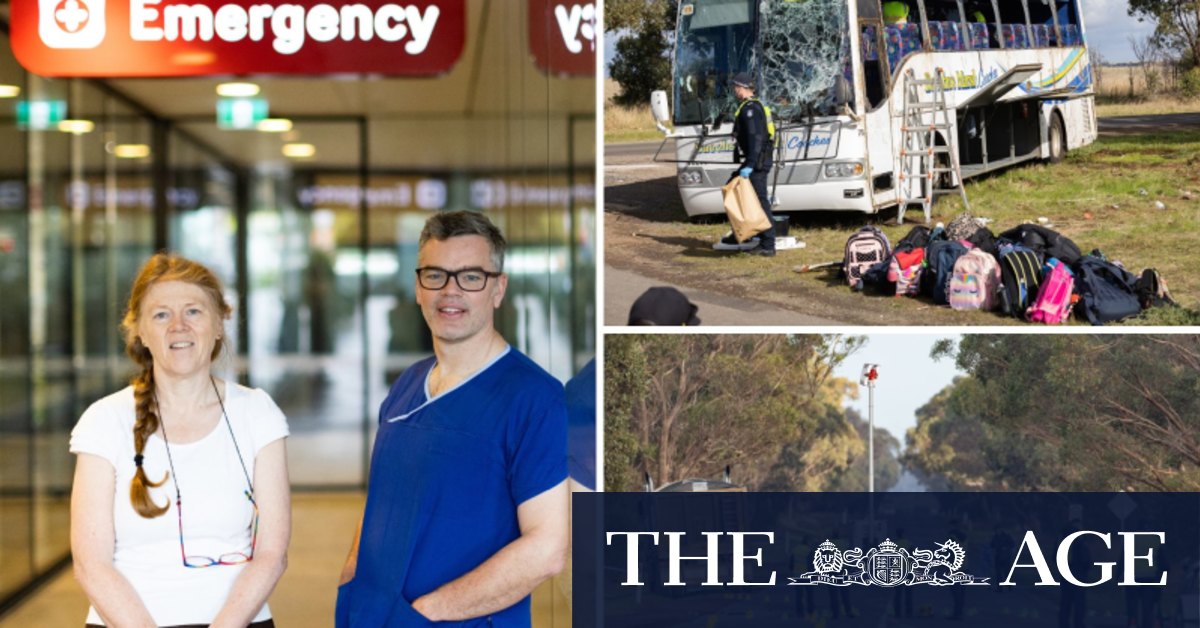
When Warwick Teague raced into the emergency room, he expected commotion. Instead, he was struck by the quietness.
Six seriously injured children had just arrived at the Royal Children’s Hospital, pulled from the wreckage of a school bus crash on Melbourne’s western fringe and then ferried in by helicopter and ambulance.
Quiet is good, the hospital’s director of trauma services thought. It means staff are focused on the job and the pain relief is working.
“The children had a sense that they were being looked after,” Teague says. “These are devastating injuries, and visually and mentally upsetting injuries.”
But behind the lack of noise, there was also adrenaline and meticulous planning. Teague and his colleagues had been preparing for years for an incident like this. Every moment and decision could have a material impact on a child’s future and quality of life. They knew what they had to do.
As soon as staff were notified by ambulance services shortly after 3.30pm on Tuesday that the most critically injured children from the Exford Primary School bus crash would soon be arriving, they sprung into action.
“There was a lot to try and get ready as quickly as possible,” Teague says.
The hospital began pulling together five teams of surgeons, doctors and nurses. It sourced additional vascular and plastic surgeons from the neighbouring Royal Melbourne Hospital, according to its plan.
Once the students arrived at the hospital, the trauma teams set about assessing their devastating injuries. Several had tourniquets that had been applied by paramedics at the crash scene to help stem the flow of blood from their limbs, which had been crushed and severed by the toppled bus.
The bus had tipped onto its left side, and many of the injuries were confined to that side of the children’s bodies.
The teams of trauma specialists assessed the children’s airways, breathing and circulation. They took blood tests so they could provide the appropriate transfusion. Those who needed surgery were whisked away to theatre and operated on by orthopaedic, plastic and vascular surgeons.
“This is the worst scale of severe injuries that we have faced in recent times,” Teague says.
The six children were among the most seriously injured, but more than a dozen in total were taken to the Royal Children’s and Sunshine hospitals after the crash.
Joanne Grindlay, the Royal Children’s Hospital’s director of emergency medicine, says she was relieved that most children had been wearing seat belts.
“This was a school bus with a large number of children on it,” she says.
“We saw nine children here. We didn’t see a whole busload of children, which is what we might have seen if they hadn’t been wearing seat belts ... a whole lot of children got out and were physically OK and seat belts had a large part to do with that.”
While many children escaped without physical injures, Grindlay says the incident would have traumatised all the children and their families.
“They’ll need lots of emotional support. Some of the injured children will need to have ongoing rehabilitation once their initial injuries are managed and obviously psychological support for them and their families.”
The hospital has also offered confidential support services to all staff who responded to the incident.
Staff weren’t just responding to the incident within the walls of the hospital.
Dr Claire Wilkins, a field emergency medical officer and paediatric emergency physician at the Royal Children’s and St Vincent’s hospitals, rushed to the site after the crash.
She had just arrived at the Royal Children’s Hospital when she was paged about the incident. She supports Ambulance Victoria, brings equipment to patients, makes rapid assessments about who first responders can manage at the site and determines where patients should go.
By the time she had arrived, it was a “well-organised scene”. The Country Fire Authority, State Emergency Service, police and ambulance were already there.
Wilkins was there for about two hours and cared for 20 to 30 patients, mostly children with wounds that needed to be irrigated or dressed.
“Sore limbs that needed to be splinted. Some pain relief, and then prioritising moving people on to a sort of warmer, more comfortable environment,” she says.
“I think it’s always challenging when there’s young children involved.”
She told ABC Radio Melbourne she carries a “mini-hospital packed in a backpack” in her car at all times.
“I think the focus for us at that time is managing the situation in front of us, regardless of what that might be, and knowing that we’ve done our best work by getting people where they need to be as soon as possible.”
With Nicole Precel
The Morning Edition newsletter is our guide to the day’s most important and interesting stories, analysis and insights. Sign up here.
https://news.google.com/rss/articles/CBMikwFodHRwczovL3d3dy50aGVhZ2UuY29tLmF1L25hdGlvbmFsL3ZpY3RvcmlhL2Zyb20taGVsaWNvcHRlci10by1ob3NwaXRhbC1pbnNpZGUtdGhlLWVyLWluLXRoZS1hZnRlcm1hdGgtb2YtdGhlLXNjaG9vbC1idXMtY3Jhc2gtMjAyMzA1MTgtcDVkOWVnLmh0bWzSAZMBaHR0cHM6Ly9hbXAudGhlYWdlLmNvbS5hdS9uYXRpb25hbC92aWN0b3JpYS9mcm9tLWhlbGljb3B0ZXItdG8taG9zcGl0YWwtaW5zaWRlLXRoZS1lci1pbi10aGUtYWZ0ZXJtYXRoLW9mLXRoZS1zY2hvb2wtYnVzLWNyYXNoLTIwMjMwNTE4LXA1ZDllZy5odG1s?oc=5
2023-05-18 09:42:45Z
2024190815
Bagikan Berita Ini














0 Response to "From helicopter to hospital: Inside the ER in the aftermath of the Exford school bus crash - The Age"
Post a Comment